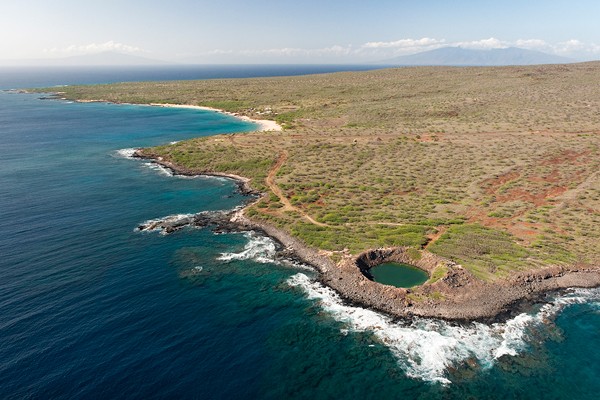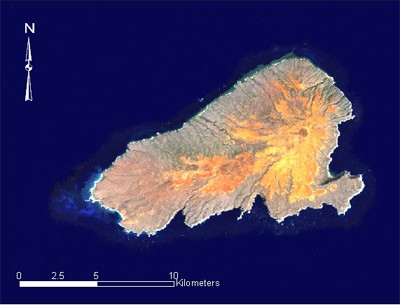Kahoolawe Island Reserve
Introduction
Text-to-speech Audio
Established in 1993, the Kahoolawe Island Reserve protects the entire island of Kahoolawe which, for several decades prior, had been used a s military bombing and training ground. The preserve protects Native Hawaiian cultural sites and efforts are ongoing to rehabilitate the island's natural environment. The island is uninhabited, largely due to is dry condition and lack of access to fresh water. No one else but native Hawaiians can access the island; they are allowed to use it for cultural, religious or agricultural purposes. The entire island, as a preserve, is listed on the National Register of Historic Places.
Images
Aerial view of the island. The small round feature on the bottom is actually a crater left from an exploding bomb.

Satellite image of the island, which was formed by a now dormant volcano.

Backstory and Context
Text-to-speech Audio
People first reached the island around 400 A.D. They remained primarily along the coast and established small fishing villages. The population grew slightly larger but it is estimated that only a few hundred lived on the island at once. Those that lived here did build religious platforms and practiced some cultivation. They also quarried for basalt to make adzes and carved petroglyphs. Their presence changed the island from a dry forest environment to a grassland savannah.
When missionaries arrived in Hawaii in the 1830s, they brought with them a new set of moral and legal codes. As a result, the death penalty was abolished and replaced with a sentence of exile. The island was chosen as an obvious place for this new form of punishment, but this only lasted until 1853. In 1857 only about 50 people lived on the island and the government opened it up for ranching. Though at time successful, the unreliability of rainfall and lack of fresh water sources made ranching very difficult. One of these ranchers, Angus MacPhee, leased a portion of his land to the U.S. Army in early 1941. After the attack on Pearl Harbor, the U.S. government instituted martial law and took over control of the island and began its the decades-long use of it as a training/bomging ground. Hawaiian efforts to stop this use began in the 1970s. It wasn't until 1990 that this officially ceased. Efforts to clean up the island of unexploded ordinance and restore its natural state continue today.
When missionaries arrived in Hawaii in the 1830s, they brought with them a new set of moral and legal codes. As a result, the death penalty was abolished and replaced with a sentence of exile. The island was chosen as an obvious place for this new form of punishment, but this only lasted until 1853. In 1857 only about 50 people lived on the island and the government opened it up for ranching. Though at time successful, the unreliability of rainfall and lack of fresh water sources made ranching very difficult. One of these ranchers, Angus MacPhee, leased a portion of his land to the U.S. Army in early 1941. After the attack on Pearl Harbor, the U.S. government instituted martial law and took over control of the island and began its the decades-long use of it as a training/bomging ground. Hawaiian efforts to stop this use began in the 1970s. It wasn't until 1990 that this officially ceased. Efforts to clean up the island of unexploded ordinance and restore its natural state continue today.
Sources
"Kahoolawe." Wikipedia. Accessed September 6, 2016. https://en.wikipedia.org/wiki/Kahoolawe.
"Kaho'olawe History." Kahoʻolawe Island Reserve Commission. Accessed September 6, 2016. http://kahoolawe.hawaii.gov/history.shtml.
